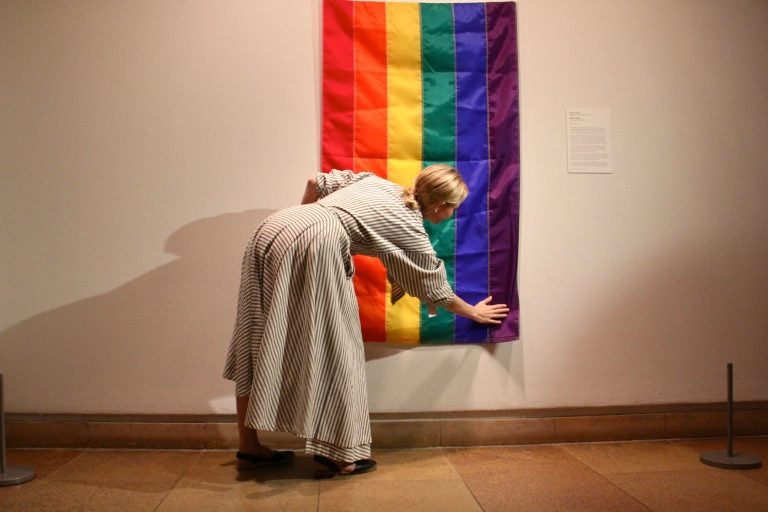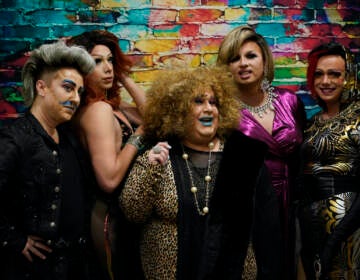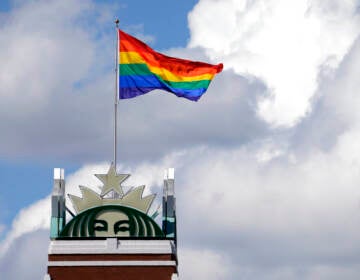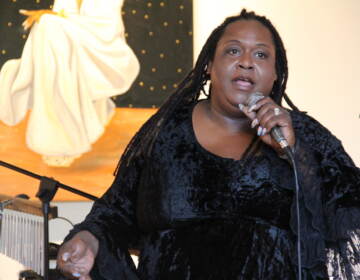Designing a movement: The rainbow flag turns 40
The rainbow flag — the icon of the LGBTQ movement for 40 years — comes to the Philadelphia Museum of Art.

Philadelphia Museum of Art Assistant Curator Michelle Millar Fisher hangs a rainbow flag marking the 40th anniversary of the unfurling of the original at the Gay Freedom Day Parade in San Francisco on June 25, 1978. The flag was designed by Gilbert Baker, who referred to himself as the "gay Betsy Ross." (Emma Lee/WHYY)
In 1978, just after his election to the San Francisco Board of Supervisors, Harvey Milk asked drag queen Gilbert Baker to make something that would lead a gay pride parade — then called Gay Freedom Day — in that city’s Castro District.
Although handy with a sewing machine —Baker made his own drag costumes — he knew he would need help designing and fabricating a flag to represent a unified community. Baker and several helpers holed up in the attic of the Castro’s gay community center and hand-dyed silk in eight colors.
“Then he needed to fix the dye. He took it to a local launderette near the end of the day, so he wouldn’t be told off. Every launderette has “No Dye” signs on the wall,” said Michelle Millar Fisher, a curator at the Philadelphia Museum of Art. “He saw all the different washing machine windows turn the colors of the rainbow, then hop-skipped it out of there before he got told off.”
On Monday, the 40th anniversary to the day of the rainbow flag’s debut in San Francisco, Fisher installed a representative flag in a gallery of the art museum, just off the Great Stair Hall.
Instead of flying on a flagpole to rally support for issues in the gay community, a flag draped on a gallery wall lends itself to contemplation about design.
The first flag was huge, about 20 feet long. Baker assigned each color a specific characteristic: sex (pink); life (red); healing (orange); sunlight, (yellow); nature (green); magic (turquoise); serenity (indigo); and spirit (violet).
That original flag also had a square of stars similar to the American flag. Baker ultimately eliminated it, and he cut the number of colors from eight to six, mostly for economic reasons related to manufacturing what had quickly become an in-demand object.
Baker never patented his design, considering it a gift to the world. He would become known as “the gay Betsy Ross,” which he co-opted for his drag performance career as “Busty Ross.”
About five months after the flag flew in the summer of 1978, Harvey Milk was shot to death in San Francisco’s City Hall. Baker, an Army veteran, died last year of a heart attack. He was 65.
The particular flag that Fisher put on display in the art museum is 3 feet by 5 feet, made of nylon, worth about $25. It’s not unique, nor historically significant. Fisher wanted an example of a very common object that shows how design is part of our everyday life.
“You might have flown this from your own flagpole in front of your house, or draped it over your shoulders at the pride parade,” she said. “We can have things at the museum that are not so unique and rare that you can’t have one. Design is, by its nature, often reproducible.”
The Philadelphia Museum of Art will host a celebration of the rainbow flag Wednesday evening. For that event, a much larger flag will drape the museum’s Great Stairs Hall.
WHYY is your source for fact-based, in-depth journalism and information. As a nonprofit organization, we rely on financial support from readers like you. Please give today.





